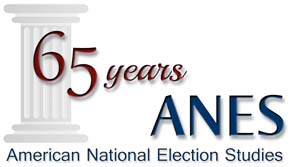Post developed by John H. Aldrich (Duke University).
This post is part of a series celebr ating the 65th anniversary of the American National Election Studies (ANES). The posts will seek to highlight some of the many ways in which the ANES has benefited scholarship, the public, and the advancement of science.
ating the 65th anniversary of the American National Election Studies (ANES). The posts will seek to highlight some of the many ways in which the ANES has benefited scholarship, the public, and the advancement of science.
My contact with the ANES began in 1966, or maybe it was in 1967, in John Kessel’s class at Allegheny College, when we read that relatively new book, The American Voter. It was presented to us then as revolutionary and that assessment stands today. Since then, it has become my good fortune to be able to be involved in the ANES, on which that book was based, in a wide variety of ways. Let me mention two dimensions of the ANES, the CSES and the future.
The Comparative Studies of Electoral Systems (CSES), led into being by Steve Rosenstone from the ANES among others, is the extension of the aspirations of the ANES into a truly comparative context. That set of aspirations was to demand the highest quality research design and data collection to enable the strongest inferences possible about how elections work. CSES is primarily the comparative study of differing democratic institutions and cultures, and the idea is to have as close to “gold standard” data collected on exactly the same topics in as many electoral democracies as possible, so we can learn just what is special to particular nations or electoral systems and what is general. The notion, that is, is to make possible the strongest science of democracy we can. We are now entering the fifth round of such studies, and the advances are becoming quite remarkable (see www.cses.org for what is nearly 20 years of research). The point is that not only was the ANES the original model, an important source of leadership, and indeed, was the justification for NSF support for the project, but all that continues to this day.
The ANES (and indeed the CSES) is entering a critical period. There are two kinds of threats, and hence two kinds of opportunities. One threat is external. The cost of the maintaining the gold standard is very high, possibly unsustainably so, and funding in the U.S., as in many nations, is under threat. In the U.S., it is under political threat, as Congress seriously considers limiting the scope of the science it will support through the NSF. The internal threat is, of course, related to cost, but it is also that maintaining the gold standard of excellence in design faces new and ever stronger challenges. While the ANES has over time maintained a position at the head of the class in terms of response rates, its current response rates, like everyone else’s, are much lower than desired and also lower than they were not so long ago. And new technologies present new challenges as to how best to meet standards of excellence in research design and survey implementation. The need for both new science and its engineering counterparts in the face of declining interest in participating in surveys and other challenges is acute – but it is also something that the scientific community surrounding and supporting the ANES ought to be especially attuned to and especially good at creating. So, this is a challenge to the community to step up, as Campbell, Converse, Miller and Stokes and as Kish did 65 years ago.

